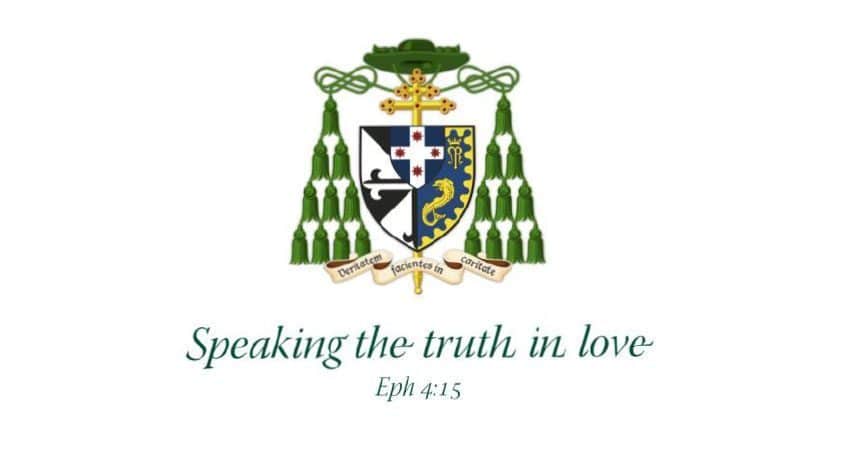200th anniversary of the preservation of the Blessed Sacrament, St. Patrick’s Church

Jeremiah O’Flynn was a ‘character’. Born in County Kerry to a tenant farmer and his wife, he suffered from wanderlust and joined a Trappist mission to the West Indies. When the monks were expelled from Martinique he stayed on, though still only a deacon, tending the Catholic slaves until he was declared incompetent by Archbishop Neale of Baltimore, who had jurisdiction over those islands. O’Flynn made for Rome to answer the accusation and there got the idea he should be chaplain to Sydney Town. He was secularised, ordained a priest and somehow got a letter of appointment. But Earl Bathurst refused to confirm it, citing O’Flynn’s ignorance both of the English language and Catholic theology! Undeterred, he sailed for Sydney and on arrival at the end of 1817 told Governor Macquarie his credentials would soon follow. Macquarie, who at that time hoped to unify the colony by extinguishing popery, forbade him to conduct his Church’s rites until instructions were received from London. O’Flynn proceeded to defy the order, conducting clandestine baptisms, confessions, marriages and Masses in Catholic homes.
One of those homes was that of William Davis, the footings of which can be seen at the Courtyard Coffee Shop on this site; another was that of James Dempsey in nearby Kent Street. Both were political prisoners, transported following the Irish Rebellion of 1798 along with our first Catholic priests – James Harold, James Dixon and Peter O’Neill. Davis and Dempsey may have been present when Dixon was briefly permitted to celebrate Mass in 1803. Both laymen were subsequently pardoned and made something of themselves. Davis donated land for the building of this church and then placed a cheque for the extraordinary sum of £1,000 upon the foundation stone after John Bede Polding had blessed it; while Dempsey contributed to the construction of St Mary’s Cathedral. Needless to say, back in 1818 the Catholics of the Colony, who now numbered 6,000 and had been without a priest since Dixon’s departure a decade before, rejoiced in O’Flynn’s ministrations. The Governor was less enthusiastic, given O’Flynn’s defiance and worst of all his penchant for converting Protestant soldiers. When no official papers for O’Flynn had arrived after six months, Macquarie had him arrested. Despite a petition from half the soldiers of the 48th Regiment who were Catholics, as well as some leading Protestants, that O’Flynn be allowed to stay, Macquarie had him shipped back home.
Further appeals to the Colonial Office were apparently of no avail. O’Flynn repaired to the West Indies, was banished from San Domingo, tried Philadelphia instead, was soon embroiled in a schism there, returned to San Domingo and was again expelled! He died while ministering to the Irish Catholics in Pennsylvania, having long exemplified an anti-authoritarianism not unparalleled in Irish-Australian clerical culture before and since.2
O’Flynn left a consecrated host in a pyx at either the Davis or Dempsey home (or both): I don’t pretend to referee that. Both homes were in any case within the bounds of what became this parish and one was on this very site. In a colony with no Catholic priest or Mass, that reserved Sacrament naturally became the focus of Catholic life. It fell to the laity to keep daily vigil before it, recite the Rosary, teach catechism there to the children, and pray Sunday Vespers. They dreamed of the day when they would be free to have both priests and sacraments in this country. Some months later, the chaplain of a visiting French naval ship consumed the Sacrament and celebrated Mass afresh for the locals. And some months after that Australia’s first official Catholic chaplains, John Joseph Therry and Philip Connolly, arrived. The petition O’Flynn carried to London had worked; Macquarie and civic authorities thereafter had to reconcile themselves to the enduring presence of Catholics and their priests.
So it is that Polding described this site as the place where ‘our religion [was] cradled and concealed, its mysteries worshipped’.3 You might even say the Church in Australia was born here, as the laity raised an irrepressible cry for the sacraments, priests were soon guaranteed, and Catholics began to assume their rightful place in this multi-religious and irreligious society. The story has many parallels with the birth of the Church we retell each Eastertide. Colonial Catholics often met in secret for fear of persecution, as the first Christians did. But they conducted their ministry of word, sacrament and service, as did those earliest Christians in our first reading today (Acts 10:25-48), ready to lay down their lives out of love, as Jesus commanded in our Gospel (Jn 15:9-17; cf. 1Jn 4:7-10). The Catholic community of The Rocks and beyond was marked not by anger or hatred, but a quiet, determined devotion.
Over the subsequent 200 years the faithful in Australia have braved many challenges and overcome grave adversity – as when colonial authorities hoped to extinguish their faith, when lack of priests meant they were long denied word and sacrament, when sectarianism in politics, education and employment kept them at the bottom of the pile, when the Church’s own failures of discerning, forming and managing its clergy and religious fuelled a terrible child abuse crisis, and when secularist interests tried and still try to marginalize the faith and the faithful from public life. In the shadow of the Royal Commission and as we await the findings of the Religious Liberty Inquiry, we must not be complacent.
Yet the Church in Australia has been graced with many strengths, also: in the laity holding fast from those early days and bringing their faith and ideals to the political and cultural life of the new nation; in missionaries such as the Marists serving in many apostolates; in religious women who built a peerless network of schools, hospitals and welfare services, especially for the most disadvantaged; in priests and bishops who served the now-1400 parishes and led the building of so much of this nation’s social capital and spiritual infrastructure; and in the wave upon wave of faithful from every nation and tongue who have made a truly ‘catholic’ Church here, and gradually rose from the bottom of the political, economic and cultural piles.
The Catholic community in Australia now offers pastoral care to millions through its parishes and chaplaincies. It provides around 10,000 hospital beds and 20,000 aged care places. It assists countless people through community services sponsored by congregations, diocesan agencies, and associations such as the St Vincent de Paul Society. It educates a fifth of all Australian children: there are now over 700,000 students in 1800 Catholic schools, including 30,000 with special needs. We connect with young adults through parish and other youth ministries, have 45,000 mostly young people in our two universities and smaller tertiary institutes, and drew 20,000 of them together for a Youth Festival here in Sydney a few months ago and hundreds of thousands to World Youth Day celebrations here a decade before.
The Plenary Council ahead demonstrates that Church leaders are alive to the challenges and the gifts we bring to: renewing and resourcing parishes to respond with evangelical creativity to the droughts, floods and fires of the age; to re-evangelising our culture, institutions and individuals; to transmitting the faith, supporting family life, and reaching out to those on the margins; to worshipping God in ways both worthy and welcoming and ensuring access to the sacraments (to the importance of which, this site stands as perpetual testimony); and thus to promoting, forming and supporting good vocations. No better motto sums up all we do and would like to do than that given us by the Lord today: to love as He has loved us.
Whatever challenges we have faced in the past, face now, or will in future, the story of this site two centuries ago offers our response: that rather than acquiescing to the spirit of the age or our own negative emotions, we must redouble our efforts to be faithful to the Lord’s command to love and breathe the Holy Spirit of quiet and humble confidence. St. Jerome told a story of St. John the Divine, by then an old man long retired from his care of the Blessed Virgin and his writing of the Gospel and Epistle we read today. He recounted that that last surviving apostle kept repeating, again and again: “My dear children, let us love one another”. Some feared this broken record reflected dotage, but when one of his disciples asked why he always said this, John replied: “Because it is the Lord’s commandment; if you keep this one commandment, it will suffice.”4
May this generation honour that of 1818 by demonstrating such faith and hope and love. Thank God for 200 years of the Faith in Australia!
INTRODUCTION TO MASS FOR 6TH SUNDAY OF EASTER YEAR B +
200TH ANNIVERSARY OF THE PRESERVATION OF THE BLESSED SACRAMENT
St. Patrick’s Church, The Rocks, 6 May 2018
How many bishops does it take to change a lightbulb?1 I’ll leave you all to answer that joke, but it clearly takes all the Bishops of Australia to celebrate a bicentenary like this one! I am delighted to join the Marist Fathers and parishioners in welcoming them on this important occasion.
Two centuries ago this month the Blessed Sacrament was reserved on or near this site. Two decades later St Patrick’s Chapel was erected here. In the 1860s the great pioneer priest and founder of the Freeman’s Journal (now the Catholic Weekly), Archdeacon John McEnroe, spent his last years as parish priest here. Before his death he expressed the wish that the French missionary fathers who were evangelising the Pacific and had recently come to Australia be given the care of this port parish. It was at his funeral in 1868 that the Marists were offered and accepted it. They’re still here after 150 years and still rendering extraordinary service! The tradition of devotion to the Blessed Sacrament continues in the umpteen Masses and many hours of adoration that take place here every week, as well as fifty and more hours of Confessions heard for the people of ‘Sin City’. My thanks to Fr Whelan, the Marist community and the bicentenary committee for all their work on bringing us together today.
It is a joy to join you all for this bicentennial celebration. To all clergy, religious and lay faithful present: a very warm welcome.
1 Answers offered include: “None: only candles allowed.” “Change the light bulb? But we’ve always used that one.” “Three: one to change the bulb and two more to do it again just in case the original change was sacramentally invalid.” “Only one: but reception of the light can take around a century.” “There is nothing in Tradition to support changing the light bulb. Or to support the existence of light bulbs for that matter.” “None: lightbulbs are usually powered by fossil fuel based electricity and have been banned by Catholic Earthcare.”
2 Brian Doyle, ‘Father O’Flynn: the first free priest to labor in Australia and his failure marked the beginning of the Church’, Catholic Weekly 16 October 1952; https://trove.nla.gov.au/newspaper/article/147086802; Vivienne Parsons, ‘O’Flynn, Jeremiah Francis (1788-1831)’, Australian Dictionary of Biography vol. 2 (1967); John Hosie, ‘Davis, Dempsey and the leaving of the Blessed Sacrament: The controversy and a possible solution’, Australasian Catholic Record 67 (1990), 81-86; Anne-Maree Whitaker, ‘Ecce homo; William Davis, James Dempsey and Father Jeremiah O’Flynn’, Australian Historical Society, Church Hill, 9 April 1995; Paul Chandler, ‘James Dempsey and John Butler: Pioneers of Australian Catholicism 1802-1838’, Carmelite Library Papers 2 (Melbourne: Carmelite Communications, 2002), 14-18; Paul Collins, A Very Contrary Irishman: The Life and Journeys of Jeremiah O’Flynn (Melbourne: Morning Star, 2014).
3 Peter McMurrich SM, The Harmonizing Influence of Religion: St. Patrick’s Church Hill, 1840 to the Present (Patrick Books, 2011/2017), p. 9
4 St. Jerome, Commentary on Gal., 3, 6, 10.

